Office Management, Employee Rights, and Business Procedures
VerifiedAdded on 2020/06/04
|23
|6924
|231
Homework Assignment
AI Summary
This assignment delves into various aspects of office management, including establishing and implementing office procedures, managing work effectiveness, and handling office constraints. It explores the design of office systems, creating a productive work environment, and handling mail efficiently, including dealing with 'junk' mail and preparing packages. The assignment also covers employee rights and responsibilities, organizational policies, and procedures. Additional topics include document production, presentation skills, principles of leadership and management, and the importance of equality, diversity, and inclusion in the workplace. The content provides a comprehensive overview of key elements essential for effective office administration and human resource management.

Paraphrase This Document
Need a fresh take? Get an instant paraphrase of this document with our AI Paraphraser
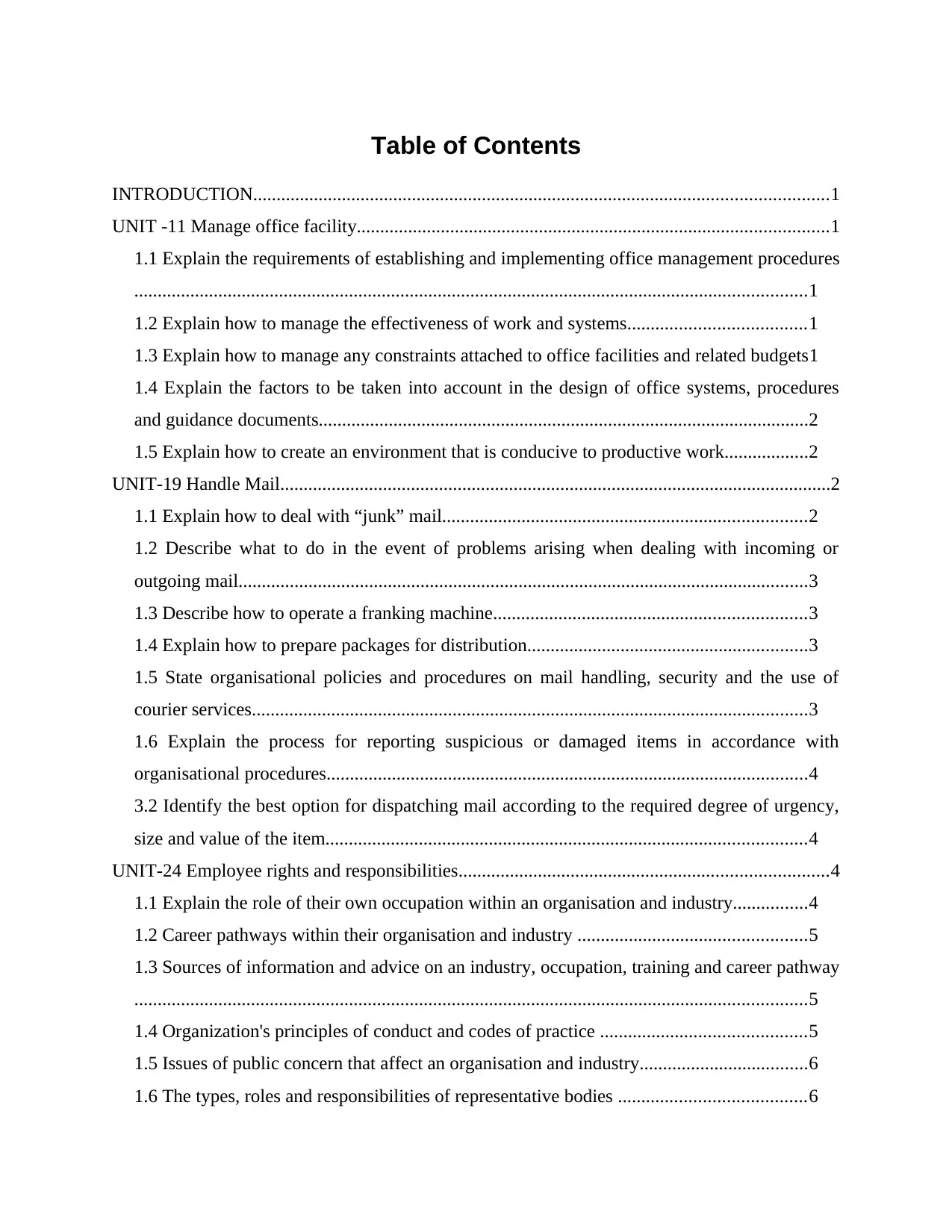
Table of Contents
INTRODUCTION...........................................................................................................................1
UNIT -11 Manage office facility.....................................................................................................1
1.1 Explain the requirements of establishing and implementing office management procedures
................................................................................................................................................1
1.2 Explain how to manage the effectiveness of work and systems......................................1
1.3 Explain how to manage any constraints attached to office facilities and related budgets1
1.4 Explain the factors to be taken into account in the design of office systems, procedures
and guidance documents.........................................................................................................2
1.5 Explain how to create an environment that is conducive to productive work..................2
UNIT-19 Handle Mail......................................................................................................................2
1.1 Explain how to deal with “junk” mail..............................................................................2
1.2 Describe what to do in the event of problems arising when dealing with incoming or
outgoing mail..........................................................................................................................3
1.3 Describe how to operate a franking machine...................................................................3
1.4 Explain how to prepare packages for distribution............................................................3
1.5 State organisational policies and procedures on mail handling, security and the use of
courier services.......................................................................................................................3
1.6 Explain the process for reporting suspicious or damaged items in accordance with
organisational procedures.......................................................................................................4
3.2 Identify the best option for dispatching mail according to the required degree of urgency,
size and value of the item.......................................................................................................4
UNIT-24 Employee rights and responsibilities...............................................................................4
1.1 Explain the role of their own occupation within an organisation and industry................4
1.2 Career pathways within their organisation and industry .................................................5
1.3 Sources of information and advice on an industry, occupation, training and career pathway
................................................................................................................................................5
1.4 Organization's principles of conduct and codes of practice ............................................5
1.5 Issues of public concern that affect an organisation and industry....................................6
1.6 The types, roles and responsibilities of representative bodies ........................................6
INTRODUCTION...........................................................................................................................1
UNIT -11 Manage office facility.....................................................................................................1
1.1 Explain the requirements of establishing and implementing office management procedures
................................................................................................................................................1
1.2 Explain how to manage the effectiveness of work and systems......................................1
1.3 Explain how to manage any constraints attached to office facilities and related budgets1
1.4 Explain the factors to be taken into account in the design of office systems, procedures
and guidance documents.........................................................................................................2
1.5 Explain how to create an environment that is conducive to productive work..................2
UNIT-19 Handle Mail......................................................................................................................2
1.1 Explain how to deal with “junk” mail..............................................................................2
1.2 Describe what to do in the event of problems arising when dealing with incoming or
outgoing mail..........................................................................................................................3
1.3 Describe how to operate a franking machine...................................................................3
1.4 Explain how to prepare packages for distribution............................................................3
1.5 State organisational policies and procedures on mail handling, security and the use of
courier services.......................................................................................................................3
1.6 Explain the process for reporting suspicious or damaged items in accordance with
organisational procedures.......................................................................................................4
3.2 Identify the best option for dispatching mail according to the required degree of urgency,
size and value of the item.......................................................................................................4
UNIT-24 Employee rights and responsibilities...............................................................................4
1.1 Explain the role of their own occupation within an organisation and industry................4
1.2 Career pathways within their organisation and industry .................................................5
1.3 Sources of information and advice on an industry, occupation, training and career pathway
................................................................................................................................................5
1.4 Organization's principles of conduct and codes of practice ............................................5
1.5 Issues of public concern that affect an organisation and industry....................................6
1.6 The types, roles and responsibilities of representative bodies ........................................6
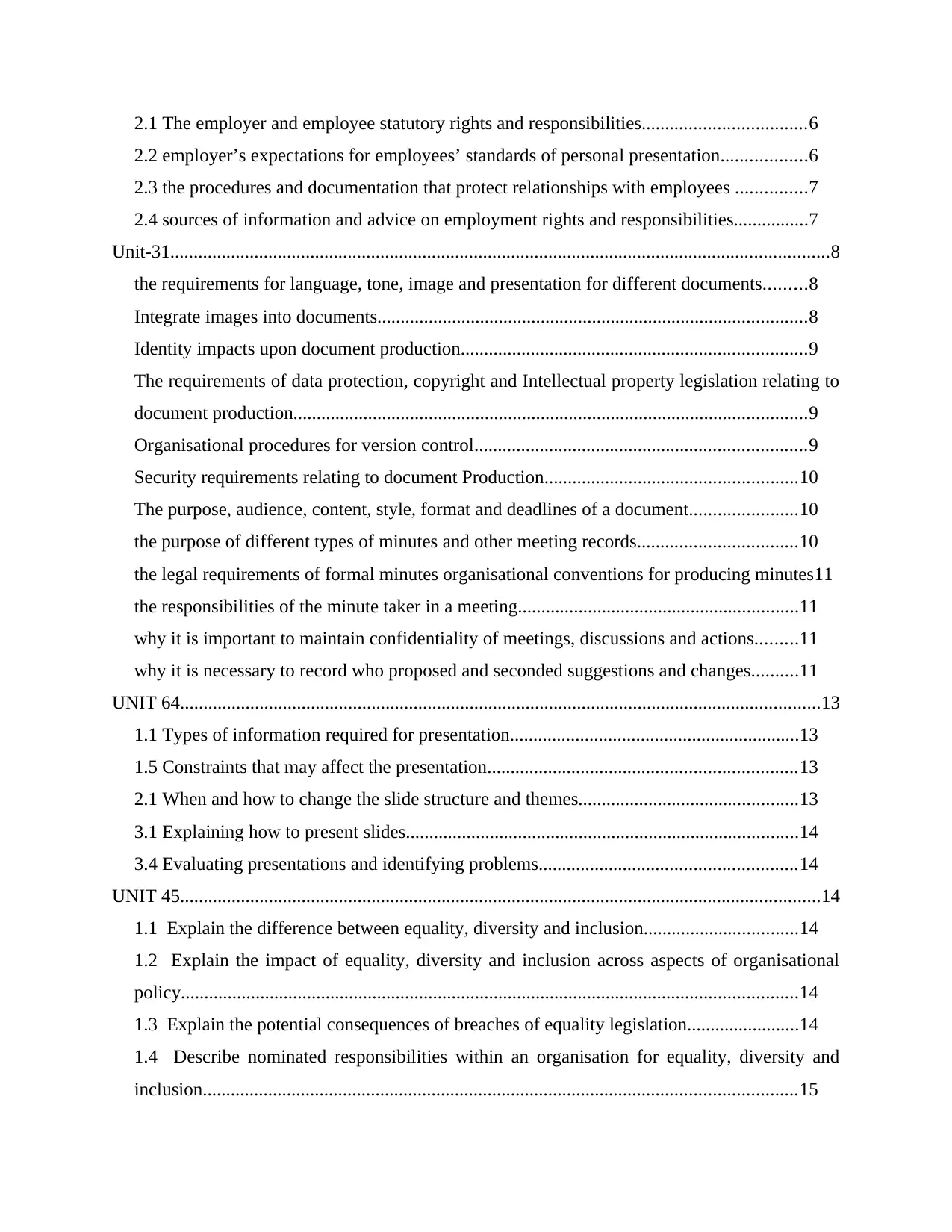
2.1 The employer and employee statutory rights and responsibilities...................................6
2.2 employer’s expectations for employees’ standards of personal presentation..................6
2.3 the procedures and documentation that protect relationships with employees ...............7
2.4 sources of information and advice on employment rights and responsibilities................7
Unit-31.............................................................................................................................................8
the requirements for language, tone, image and presentation for different documents.........8
Integrate images into documents............................................................................................8
Identity impacts upon document production..........................................................................9
The requirements of data protection, copyright and Intellectual property legislation relating to
document production..............................................................................................................9
Organisational procedures for version control.......................................................................9
Security requirements relating to document Production......................................................10
The purpose, audience, content, style, format and deadlines of a document.......................10
the purpose of different types of minutes and other meeting records..................................10
the legal requirements of formal minutes organisational conventions for producing minutes11
the responsibilities of the minute taker in a meeting............................................................11
why it is important to maintain confidentiality of meetings, discussions and actions.........11
why it is necessary to record who proposed and seconded suggestions and changes..........11
UNIT 64.........................................................................................................................................13
1.1 Types of information required for presentation..............................................................13
1.5 Constraints that may affect the presentation..................................................................13
2.1 When and how to change the slide structure and themes...............................................13
3.1 Explaining how to present slides....................................................................................14
3.4 Evaluating presentations and identifying problems.......................................................14
UNIT 45.........................................................................................................................................14
1.1 Explain the difference between equality, diversity and inclusion.................................14
1.2 Explain the impact of equality, diversity and inclusion across aspects of organisational
policy....................................................................................................................................14
1.3 Explain the potential consequences of breaches of equality legislation........................14
1.4 Describe nominated responsibilities within an organisation for equality, diversity and
inclusion...............................................................................................................................15
2.2 employer’s expectations for employees’ standards of personal presentation..................6
2.3 the procedures and documentation that protect relationships with employees ...............7
2.4 sources of information and advice on employment rights and responsibilities................7
Unit-31.............................................................................................................................................8
the requirements for language, tone, image and presentation for different documents.........8
Integrate images into documents............................................................................................8
Identity impacts upon document production..........................................................................9
The requirements of data protection, copyright and Intellectual property legislation relating to
document production..............................................................................................................9
Organisational procedures for version control.......................................................................9
Security requirements relating to document Production......................................................10
The purpose, audience, content, style, format and deadlines of a document.......................10
the purpose of different types of minutes and other meeting records..................................10
the legal requirements of formal minutes organisational conventions for producing minutes11
the responsibilities of the minute taker in a meeting............................................................11
why it is important to maintain confidentiality of meetings, discussions and actions.........11
why it is necessary to record who proposed and seconded suggestions and changes..........11
UNIT 64.........................................................................................................................................13
1.1 Types of information required for presentation..............................................................13
1.5 Constraints that may affect the presentation..................................................................13
2.1 When and how to change the slide structure and themes...............................................13
3.1 Explaining how to present slides....................................................................................14
3.4 Evaluating presentations and identifying problems.......................................................14
UNIT 45.........................................................................................................................................14
1.1 Explain the difference between equality, diversity and inclusion.................................14
1.2 Explain the impact of equality, diversity and inclusion across aspects of organisational
policy....................................................................................................................................14
1.3 Explain the potential consequences of breaches of equality legislation........................14
1.4 Describe nominated responsibilities within an organisation for equality, diversity and
inclusion...............................................................................................................................15
⊘ This is a preview!⊘
Do you want full access?
Subscribe today to unlock all pages.

Trusted by 1+ million students worldwide
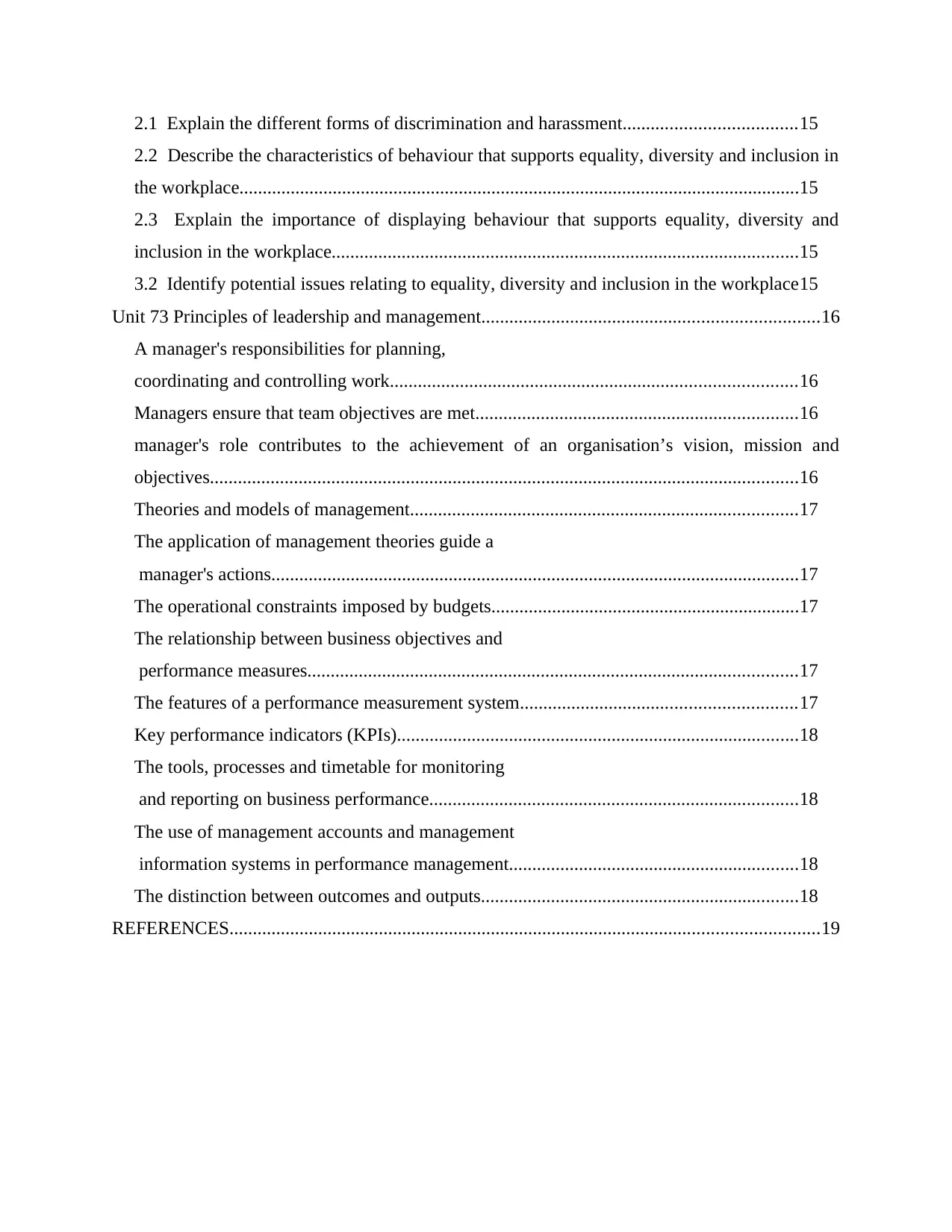
2.1 Explain the different forms of discrimination and harassment.....................................15
2.2 Describe the characteristics of behaviour that supports equality, diversity and inclusion in
the workplace........................................................................................................................15
2.3 Explain the importance of displaying behaviour that supports equality, diversity and
inclusion in the workplace....................................................................................................15
3.2 Identify potential issues relating to equality, diversity and inclusion in the workplace15
Unit 73 Principles of leadership and management........................................................................16
A manager's responsibilities for planning,
coordinating and controlling work.......................................................................................16
Managers ensure that team objectives are met.....................................................................16
manager's role contributes to the achievement of an organisation’s vision, mission and
objectives..............................................................................................................................16
Theories and models of management...................................................................................17
The application of management theories guide a
manager's actions.................................................................................................................17
The operational constraints imposed by budgets..................................................................17
The relationship between business objectives and
performance measures.........................................................................................................17
The features of a performance measurement system...........................................................17
Key performance indicators (KPIs)......................................................................................18
The tools, processes and timetable for monitoring
and reporting on business performance...............................................................................18
The use of management accounts and management
information systems in performance management..............................................................18
The distinction between outcomes and outputs....................................................................18
REFERENCES..............................................................................................................................19
2.2 Describe the characteristics of behaviour that supports equality, diversity and inclusion in
the workplace........................................................................................................................15
2.3 Explain the importance of displaying behaviour that supports equality, diversity and
inclusion in the workplace....................................................................................................15
3.2 Identify potential issues relating to equality, diversity and inclusion in the workplace15
Unit 73 Principles of leadership and management........................................................................16
A manager's responsibilities for planning,
coordinating and controlling work.......................................................................................16
Managers ensure that team objectives are met.....................................................................16
manager's role contributes to the achievement of an organisation’s vision, mission and
objectives..............................................................................................................................16
Theories and models of management...................................................................................17
The application of management theories guide a
manager's actions.................................................................................................................17
The operational constraints imposed by budgets..................................................................17
The relationship between business objectives and
performance measures.........................................................................................................17
The features of a performance measurement system...........................................................17
Key performance indicators (KPIs)......................................................................................18
The tools, processes and timetable for monitoring
and reporting on business performance...............................................................................18
The use of management accounts and management
information systems in performance management..............................................................18
The distinction between outcomes and outputs....................................................................18
REFERENCES..............................................................................................................................19
Paraphrase This Document
Need a fresh take? Get an instant paraphrase of this document with our AI Paraphraser
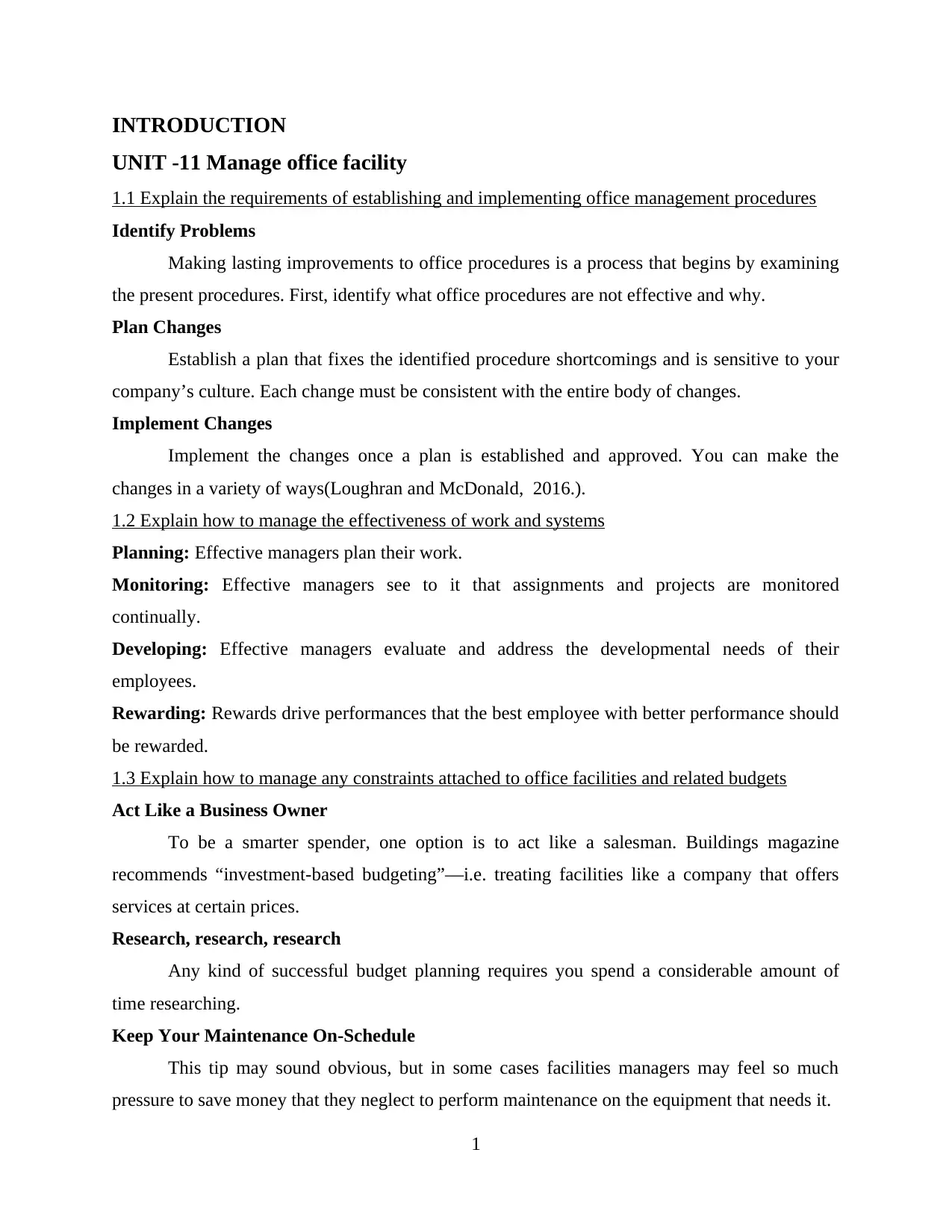
INTRODUCTION
UNIT -11 Manage office facility
1.1 Explain the requirements of establishing and implementing office management procedures
Identify Problems
Making lasting improvements to office procedures is a process that begins by examining
the present procedures. First, identify what office procedures are not effective and why.
Plan Changes
Establish a plan that fixes the identified procedure shortcomings and is sensitive to your
company’s culture. Each change must be consistent with the entire body of changes.
Implement Changes
Implement the changes once a plan is established and approved. You can make the
changes in a variety of ways(Loughran and McDonald, 2016.).
1.2 Explain how to manage the effectiveness of work and systems
Planning: Effective managers plan their work.
Monitoring: Effective managers see to it that assignments and projects are monitored
continually.
Developing: Effective managers evaluate and address the developmental needs of their
employees.
Rewarding: Rewards drive performances that the best employee with better performance should
be rewarded.
1.3 Explain how to manage any constraints attached to office facilities and related budgets
Act Like a Business Owner
To be a smarter spender, one option is to act like a salesman. Buildings magazine
recommends “investment-based budgeting”—i.e. treating facilities like a company that offers
services at certain prices.
Research, research, research
Any kind of successful budget planning requires you spend a considerable amount of
time researching.
Keep Your Maintenance On-Schedule
This tip may sound obvious, but in some cases facilities managers may feel so much
pressure to save money that they neglect to perform maintenance on the equipment that needs it.
1
UNIT -11 Manage office facility
1.1 Explain the requirements of establishing and implementing office management procedures
Identify Problems
Making lasting improvements to office procedures is a process that begins by examining
the present procedures. First, identify what office procedures are not effective and why.
Plan Changes
Establish a plan that fixes the identified procedure shortcomings and is sensitive to your
company’s culture. Each change must be consistent with the entire body of changes.
Implement Changes
Implement the changes once a plan is established and approved. You can make the
changes in a variety of ways(Loughran and McDonald, 2016.).
1.2 Explain how to manage the effectiveness of work and systems
Planning: Effective managers plan their work.
Monitoring: Effective managers see to it that assignments and projects are monitored
continually.
Developing: Effective managers evaluate and address the developmental needs of their
employees.
Rewarding: Rewards drive performances that the best employee with better performance should
be rewarded.
1.3 Explain how to manage any constraints attached to office facilities and related budgets
Act Like a Business Owner
To be a smarter spender, one option is to act like a salesman. Buildings magazine
recommends “investment-based budgeting”—i.e. treating facilities like a company that offers
services at certain prices.
Research, research, research
Any kind of successful budget planning requires you spend a considerable amount of
time researching.
Keep Your Maintenance On-Schedule
This tip may sound obvious, but in some cases facilities managers may feel so much
pressure to save money that they neglect to perform maintenance on the equipment that needs it.
1
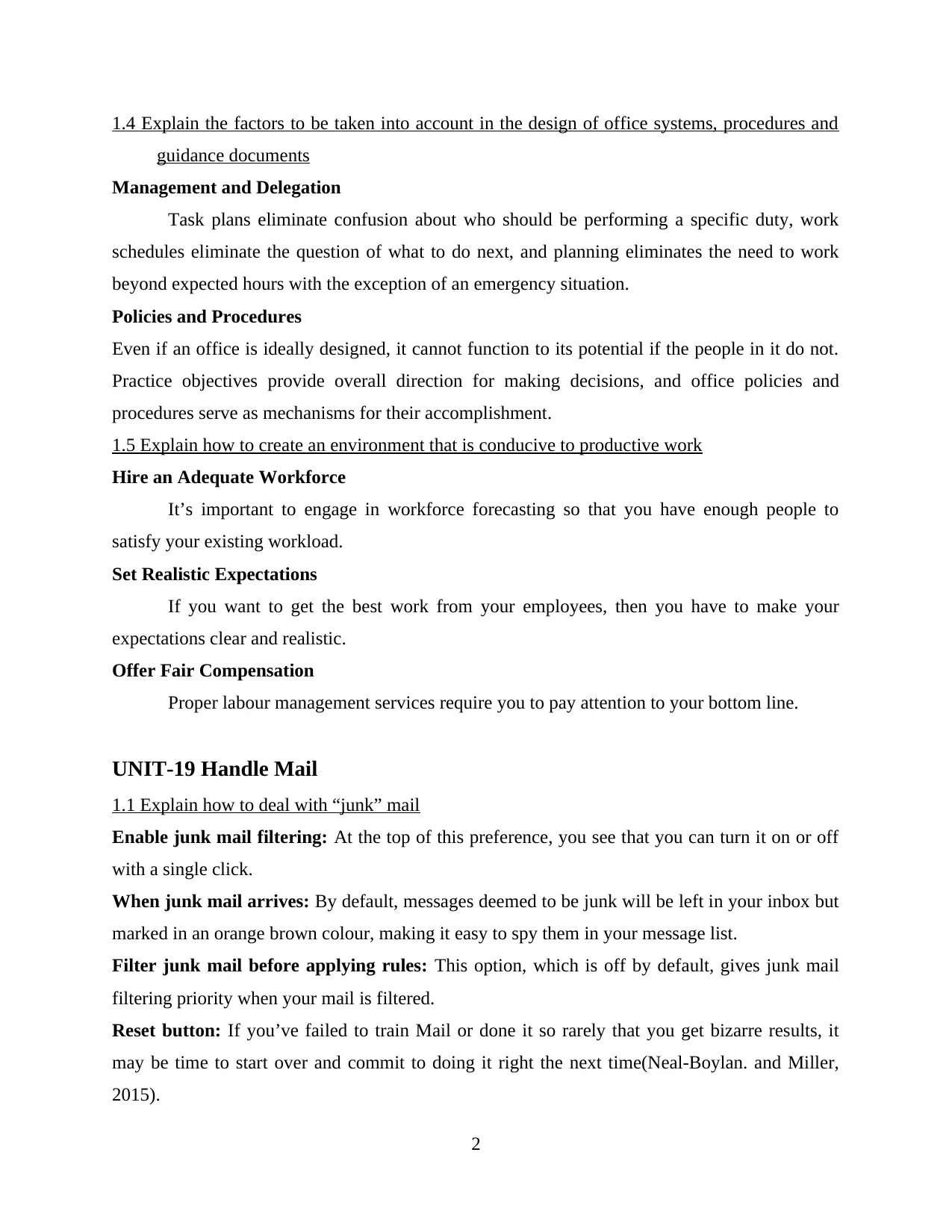
1.4 Explain the factors to be taken into account in the design of office systems, procedures and
guidance documents
Management and Delegation
Task plans eliminate confusion about who should be performing a specific duty, work
schedules eliminate the question of what to do next, and planning eliminates the need to work
beyond expected hours with the exception of an emergency situation.
Policies and Procedures
Even if an office is ideally designed, it cannot function to its potential if the people in it do not.
Practice objectives provide overall direction for making decisions, and office policies and
procedures serve as mechanisms for their accomplishment.
1.5 Explain how to create an environment that is conducive to productive work
Hire an Adequate Workforce
It’s important to engage in workforce forecasting so that you have enough people to
satisfy your existing workload.
Set Realistic Expectations
If you want to get the best work from your employees, then you have to make your
expectations clear and realistic.
Offer Fair Compensation
Proper labour management services require you to pay attention to your bottom line.
UNIT-19 Handle Mail
1.1 Explain how to deal with “junk” mail
Enable junk mail filtering: At the top of this preference, you see that you can turn it on or off
with a single click.
When junk mail arrives: By default, messages deemed to be junk will be left in your inbox but
marked in an orange brown colour, making it easy to spy them in your message list.
Filter junk mail before applying rules: This option, which is off by default, gives junk mail
filtering priority when your mail is filtered.
Reset button: If you’ve failed to train Mail or done it so rarely that you get bizarre results, it
may be time to start over and commit to doing it right the next time(Neal‐Boylan. and Miller,
2015).
2
guidance documents
Management and Delegation
Task plans eliminate confusion about who should be performing a specific duty, work
schedules eliminate the question of what to do next, and planning eliminates the need to work
beyond expected hours with the exception of an emergency situation.
Policies and Procedures
Even if an office is ideally designed, it cannot function to its potential if the people in it do not.
Practice objectives provide overall direction for making decisions, and office policies and
procedures serve as mechanisms for their accomplishment.
1.5 Explain how to create an environment that is conducive to productive work
Hire an Adequate Workforce
It’s important to engage in workforce forecasting so that you have enough people to
satisfy your existing workload.
Set Realistic Expectations
If you want to get the best work from your employees, then you have to make your
expectations clear and realistic.
Offer Fair Compensation
Proper labour management services require you to pay attention to your bottom line.
UNIT-19 Handle Mail
1.1 Explain how to deal with “junk” mail
Enable junk mail filtering: At the top of this preference, you see that you can turn it on or off
with a single click.
When junk mail arrives: By default, messages deemed to be junk will be left in your inbox but
marked in an orange brown colour, making it easy to spy them in your message list.
Filter junk mail before applying rules: This option, which is off by default, gives junk mail
filtering priority when your mail is filtered.
Reset button: If you’ve failed to train Mail or done it so rarely that you get bizarre results, it
may be time to start over and commit to doing it right the next time(Neal‐Boylan. and Miller,
2015).
2
⊘ This is a preview!⊘
Do you want full access?
Subscribe today to unlock all pages.

Trusted by 1+ million students worldwide
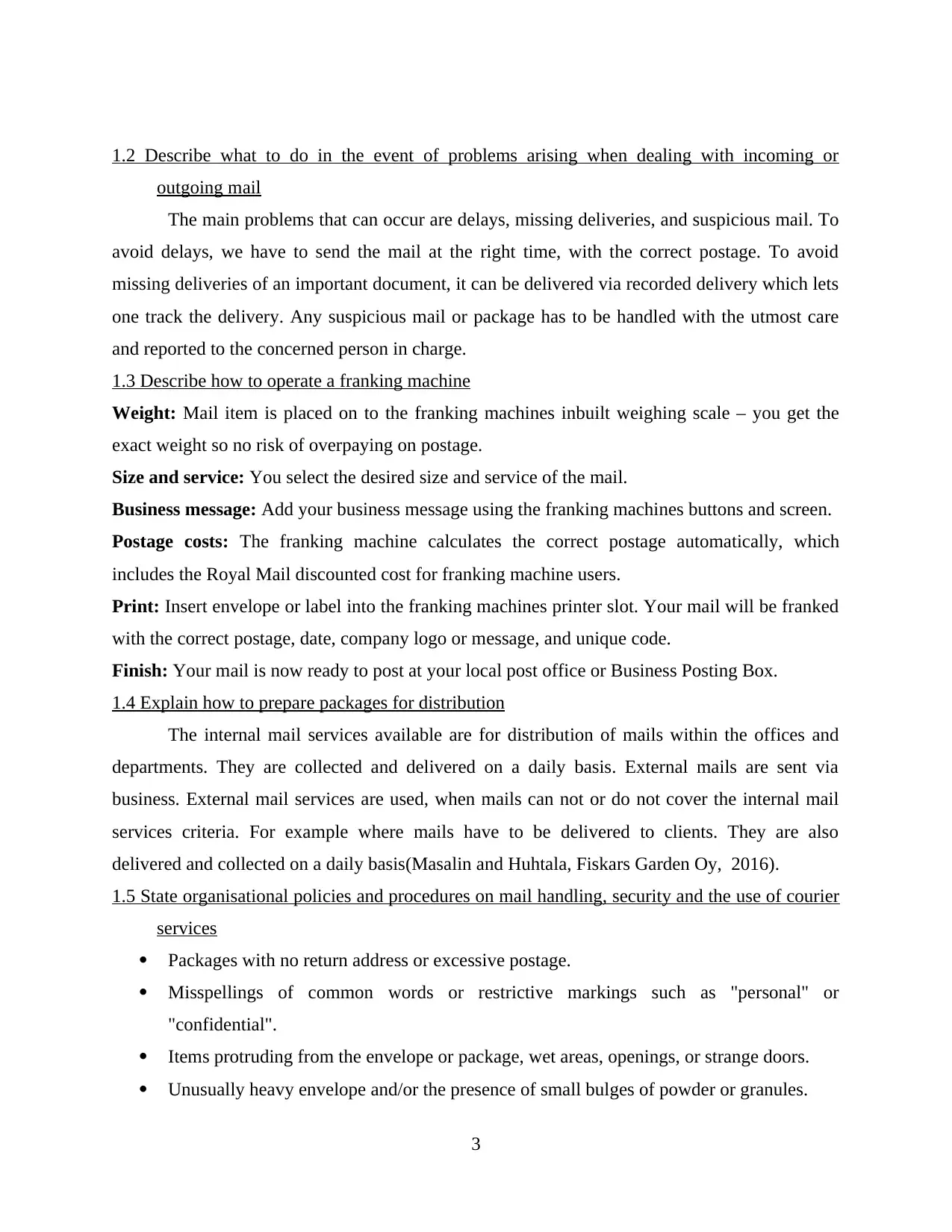
1.2 Describe what to do in the event of problems arising when dealing with incoming or
outgoing mail
The main problems that can occur are delays, missing deliveries, and suspicious mail. To
avoid delays, we have to send the mail at the right time, with the correct postage. To avoid
missing deliveries of an important document, it can be delivered via recorded delivery which lets
one track the delivery. Any suspicious mail or package has to be handled with the utmost care
and reported to the concerned person in charge.
1.3 Describe how to operate a franking machine
Weight: Mail item is placed on to the franking machines inbuilt weighing scale – you get the
exact weight so no risk of overpaying on postage.
Size and service: You select the desired size and service of the mail.
Business message: Add your business message using the franking machines buttons and screen.
Postage costs: The franking machine calculates the correct postage automatically, which
includes the Royal Mail discounted cost for franking machine users.
Print: Insert envelope or label into the franking machines printer slot. Your mail will be franked
with the correct postage, date, company logo or message, and unique code.
Finish: Your mail is now ready to post at your local post office or Business Posting Box.
1.4 Explain how to prepare packages for distribution
The internal mail services available are for distribution of mails within the offices and
departments. They are collected and delivered on a daily basis. External mails are sent via
business. External mail services are used, when mails can not or do not cover the internal mail
services criteria. For example where mails have to be delivered to clients. They are also
delivered and collected on a daily basis(Masalin and Huhtala, Fiskars Garden Oy, 2016).
1.5 State organisational policies and procedures on mail handling, security and the use of courier
services
Packages with no return address or excessive postage.
Misspellings of common words or restrictive markings such as "personal" or
"confidential".
Items protruding from the envelope or package, wet areas, openings, or strange doors.
Unusually heavy envelope and/or the presence of small bulges of powder or granules.
3
outgoing mail
The main problems that can occur are delays, missing deliveries, and suspicious mail. To
avoid delays, we have to send the mail at the right time, with the correct postage. To avoid
missing deliveries of an important document, it can be delivered via recorded delivery which lets
one track the delivery. Any suspicious mail or package has to be handled with the utmost care
and reported to the concerned person in charge.
1.3 Describe how to operate a franking machine
Weight: Mail item is placed on to the franking machines inbuilt weighing scale – you get the
exact weight so no risk of overpaying on postage.
Size and service: You select the desired size and service of the mail.
Business message: Add your business message using the franking machines buttons and screen.
Postage costs: The franking machine calculates the correct postage automatically, which
includes the Royal Mail discounted cost for franking machine users.
Print: Insert envelope or label into the franking machines printer slot. Your mail will be franked
with the correct postage, date, company logo or message, and unique code.
Finish: Your mail is now ready to post at your local post office or Business Posting Box.
1.4 Explain how to prepare packages for distribution
The internal mail services available are for distribution of mails within the offices and
departments. They are collected and delivered on a daily basis. External mails are sent via
business. External mail services are used, when mails can not or do not cover the internal mail
services criteria. For example where mails have to be delivered to clients. They are also
delivered and collected on a daily basis(Masalin and Huhtala, Fiskars Garden Oy, 2016).
1.5 State organisational policies and procedures on mail handling, security and the use of courier
services
Packages with no return address or excessive postage.
Misspellings of common words or restrictive markings such as "personal" or
"confidential".
Items protruding from the envelope or package, wet areas, openings, or strange doors.
Unusually heavy envelope and/or the presence of small bulges of powder or granules.
3
Paraphrase This Document
Need a fresh take? Get an instant paraphrase of this document with our AI Paraphraser
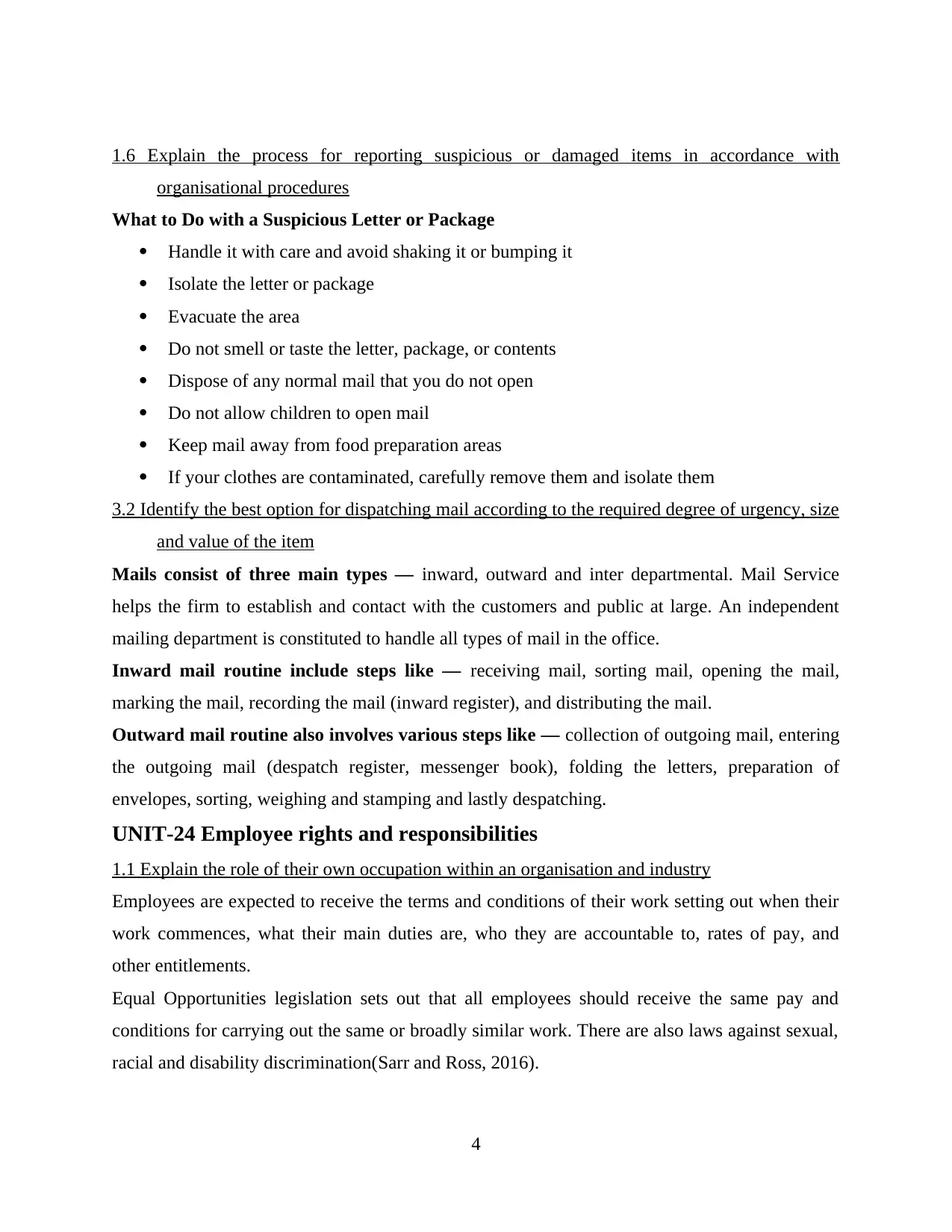
1.6 Explain the process for reporting suspicious or damaged items in accordance with
organisational procedures
What to Do with a Suspicious Letter or Package
Handle it with care and avoid shaking it or bumping it
Isolate the letter or package
Evacuate the area
Do not smell or taste the letter, package, or contents
Dispose of any normal mail that you do not open
Do not allow children to open mail
Keep mail away from food preparation areas
If your clothes are contaminated, carefully remove them and isolate them
3.2 Identify the best option for dispatching mail according to the required degree of urgency, size
and value of the item
Mails consist of three main types — inward, outward and inter departmental. Mail Service
helps the firm to establish and contact with the customers and public at large. An independent
mailing department is constituted to handle all types of mail in the office.
Inward mail routine include steps like — receiving mail, sorting mail, opening the mail,
marking the mail, recording the mail (inward register), and distributing the mail.
Outward mail routine also involves various steps like — collection of outgoing mail, entering
the outgoing mail (despatch register, messenger book), folding the letters, preparation of
envelopes, sorting, weighing and stamping and lastly despatching.
UNIT-24 Employee rights and responsibilities
1.1 Explain the role of their own occupation within an organisation and industry
Employees are expected to receive the terms and conditions of their work setting out when their
work commences, what their main duties are, who they are accountable to, rates of pay, and
other entitlements.
Equal Opportunities legislation sets out that all employees should receive the same pay and
conditions for carrying out the same or broadly similar work. There are also laws against sexual,
racial and disability discrimination(Sarr and Ross, 2016).
4
organisational procedures
What to Do with a Suspicious Letter or Package
Handle it with care and avoid shaking it or bumping it
Isolate the letter or package
Evacuate the area
Do not smell or taste the letter, package, or contents
Dispose of any normal mail that you do not open
Do not allow children to open mail
Keep mail away from food preparation areas
If your clothes are contaminated, carefully remove them and isolate them
3.2 Identify the best option for dispatching mail according to the required degree of urgency, size
and value of the item
Mails consist of three main types — inward, outward and inter departmental. Mail Service
helps the firm to establish and contact with the customers and public at large. An independent
mailing department is constituted to handle all types of mail in the office.
Inward mail routine include steps like — receiving mail, sorting mail, opening the mail,
marking the mail, recording the mail (inward register), and distributing the mail.
Outward mail routine also involves various steps like — collection of outgoing mail, entering
the outgoing mail (despatch register, messenger book), folding the letters, preparation of
envelopes, sorting, weighing and stamping and lastly despatching.
UNIT-24 Employee rights and responsibilities
1.1 Explain the role of their own occupation within an organisation and industry
Employees are expected to receive the terms and conditions of their work setting out when their
work commences, what their main duties are, who they are accountable to, rates of pay, and
other entitlements.
Equal Opportunities legislation sets out that all employees should receive the same pay and
conditions for carrying out the same or broadly similar work. There are also laws against sexual,
racial and disability discrimination(Sarr and Ross, 2016).
4
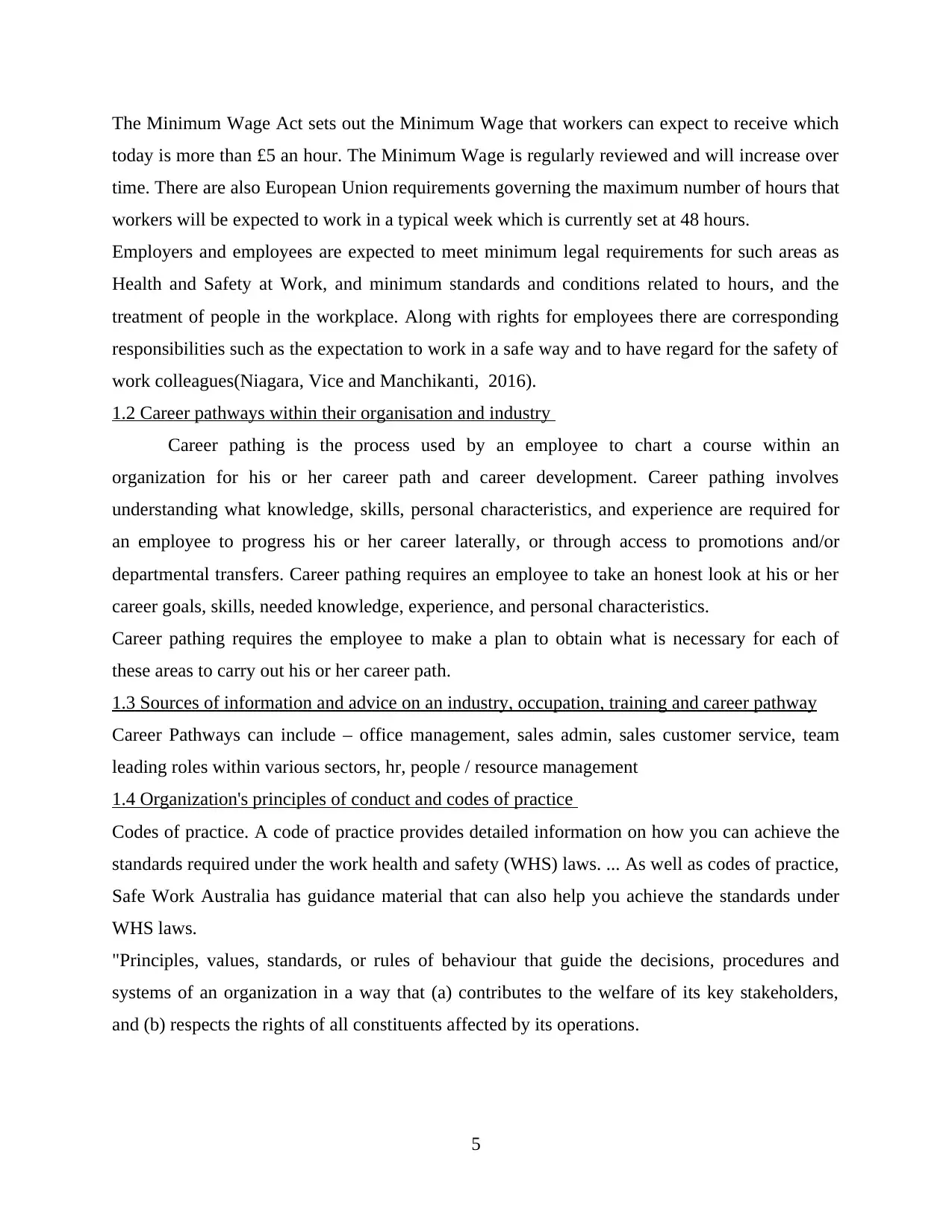
The Minimum Wage Act sets out the Minimum Wage that workers can expect to receive which
today is more than £5 an hour. The Minimum Wage is regularly reviewed and will increase over
time. There are also European Union requirements governing the maximum number of hours that
workers will be expected to work in a typical week which is currently set at 48 hours.
Employers and employees are expected to meet minimum legal requirements for such areas as
Health and Safety at Work, and minimum standards and conditions related to hours, and the
treatment of people in the workplace. Along with rights for employees there are corresponding
responsibilities such as the expectation to work in a safe way and to have regard for the safety of
work colleagues(Niagara, Vice and Manchikanti, 2016).
1.2 Career pathways within their organisation and industry
Career pathing is the process used by an employee to chart a course within an
organization for his or her career path and career development. Career pathing involves
understanding what knowledge, skills, personal characteristics, and experience are required for
an employee to progress his or her career laterally, or through access to promotions and/or
departmental transfers. Career pathing requires an employee to take an honest look at his or her
career goals, skills, needed knowledge, experience, and personal characteristics.
Career pathing requires the employee to make a plan to obtain what is necessary for each of
these areas to carry out his or her career path.
1.3 Sources of information and advice on an industry, occupation, training and career pathway
Career Pathways can include – office management, sales admin, sales customer service, team
leading roles within various sectors, hr, people / resource management
1.4 Organization's principles of conduct and codes of practice
Codes of practice. A code of practice provides detailed information on how you can achieve the
standards required under the work health and safety (WHS) laws. ... As well as codes of practice,
Safe Work Australia has guidance material that can also help you achieve the standards under
WHS laws.
"Principles, values, standards, or rules of behaviour that guide the decisions, procedures and
systems of an organization in a way that (a) contributes to the welfare of its key stakeholders,
and (b) respects the rights of all constituents affected by its operations.
5
today is more than £5 an hour. The Minimum Wage is regularly reviewed and will increase over
time. There are also European Union requirements governing the maximum number of hours that
workers will be expected to work in a typical week which is currently set at 48 hours.
Employers and employees are expected to meet minimum legal requirements for such areas as
Health and Safety at Work, and minimum standards and conditions related to hours, and the
treatment of people in the workplace. Along with rights for employees there are corresponding
responsibilities such as the expectation to work in a safe way and to have regard for the safety of
work colleagues(Niagara, Vice and Manchikanti, 2016).
1.2 Career pathways within their organisation and industry
Career pathing is the process used by an employee to chart a course within an
organization for his or her career path and career development. Career pathing involves
understanding what knowledge, skills, personal characteristics, and experience are required for
an employee to progress his or her career laterally, or through access to promotions and/or
departmental transfers. Career pathing requires an employee to take an honest look at his or her
career goals, skills, needed knowledge, experience, and personal characteristics.
Career pathing requires the employee to make a plan to obtain what is necessary for each of
these areas to carry out his or her career path.
1.3 Sources of information and advice on an industry, occupation, training and career pathway
Career Pathways can include – office management, sales admin, sales customer service, team
leading roles within various sectors, hr, people / resource management
1.4 Organization's principles of conduct and codes of practice
Codes of practice. A code of practice provides detailed information on how you can achieve the
standards required under the work health and safety (WHS) laws. ... As well as codes of practice,
Safe Work Australia has guidance material that can also help you achieve the standards under
WHS laws.
"Principles, values, standards, or rules of behaviour that guide the decisions, procedures and
systems of an organization in a way that (a) contributes to the welfare of its key stakeholders,
and (b) respects the rights of all constituents affected by its operations.
5
⊘ This is a preview!⊘
Do you want full access?
Subscribe today to unlock all pages.

Trusted by 1+ million students worldwide
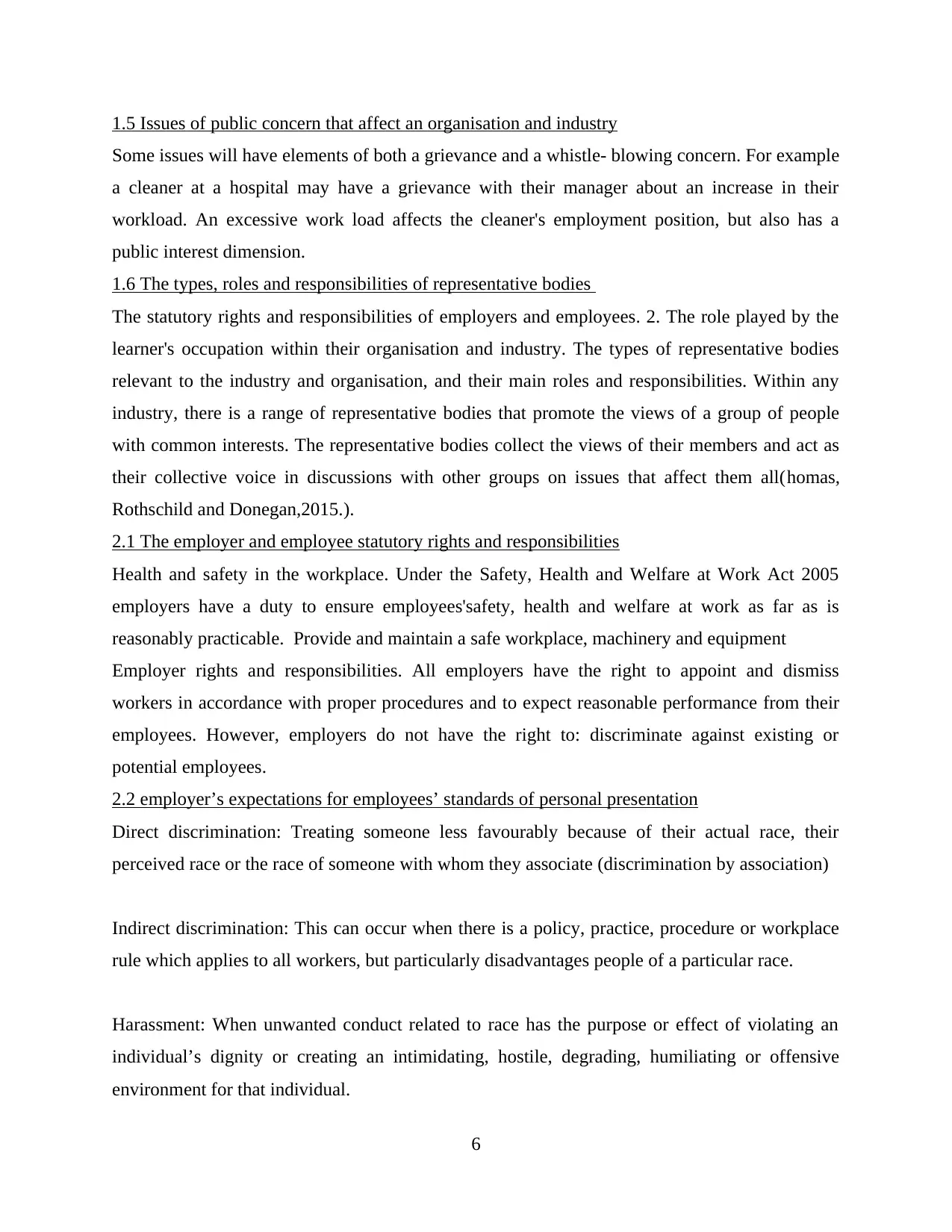
1.5 Issues of public concern that affect an organisation and industry
Some issues will have elements of both a grievance and a whistle- blowing concern. For example
a cleaner at a hospital may have a grievance with their manager about an increase in their
workload. An excessive work load affects the cleaner's employment position, but also has a
public interest dimension.
1.6 The types, roles and responsibilities of representative bodies
The statutory rights and responsibilities of employers and employees. 2. The role played by the
learner's occupation within their organisation and industry. The types of representative bodies
relevant to the industry and organisation, and their main roles and responsibilities. Within any
industry, there is a range of representative bodies that promote the views of a group of people
with common interests. The representative bodies collect the views of their members and act as
their collective voice in discussions with other groups on issues that affect them all(homas,
Rothschild and Donegan,2015.).
2.1 The employer and employee statutory rights and responsibilities
Health and safety in the workplace. Under the Safety, Health and Welfare at Work Act 2005
employers have a duty to ensure employees'safety, health and welfare at work as far as is
reasonably practicable. Provide and maintain a safe workplace, machinery and equipment
Employer rights and responsibilities. All employers have the right to appoint and dismiss
workers in accordance with proper procedures and to expect reasonable performance from their
employees. However, employers do not have the right to: discriminate against existing or
potential employees.
2.2 employer’s expectations for employees’ standards of personal presentation
Direct discrimination: Treating someone less favourably because of their actual race, their
perceived race or the race of someone with whom they associate (discrimination by association)
Indirect discrimination: This can occur when there is a policy, practice, procedure or workplace
rule which applies to all workers, but particularly disadvantages people of a particular race.
Harassment: When unwanted conduct related to race has the purpose or effect of violating an
individual’s dignity or creating an intimidating, hostile, degrading, humiliating or offensive
environment for that individual.
6
Some issues will have elements of both a grievance and a whistle- blowing concern. For example
a cleaner at a hospital may have a grievance with their manager about an increase in their
workload. An excessive work load affects the cleaner's employment position, but also has a
public interest dimension.
1.6 The types, roles and responsibilities of representative bodies
The statutory rights and responsibilities of employers and employees. 2. The role played by the
learner's occupation within their organisation and industry. The types of representative bodies
relevant to the industry and organisation, and their main roles and responsibilities. Within any
industry, there is a range of representative bodies that promote the views of a group of people
with common interests. The representative bodies collect the views of their members and act as
their collective voice in discussions with other groups on issues that affect them all(homas,
Rothschild and Donegan,2015.).
2.1 The employer and employee statutory rights and responsibilities
Health and safety in the workplace. Under the Safety, Health and Welfare at Work Act 2005
employers have a duty to ensure employees'safety, health and welfare at work as far as is
reasonably practicable. Provide and maintain a safe workplace, machinery and equipment
Employer rights and responsibilities. All employers have the right to appoint and dismiss
workers in accordance with proper procedures and to expect reasonable performance from their
employees. However, employers do not have the right to: discriminate against existing or
potential employees.
2.2 employer’s expectations for employees’ standards of personal presentation
Direct discrimination: Treating someone less favourably because of their actual race, their
perceived race or the race of someone with whom they associate (discrimination by association)
Indirect discrimination: This can occur when there is a policy, practice, procedure or workplace
rule which applies to all workers, but particularly disadvantages people of a particular race.
Harassment: When unwanted conduct related to race has the purpose or effect of violating an
individual’s dignity or creating an intimidating, hostile, degrading, humiliating or offensive
environment for that individual.
6
Paraphrase This Document
Need a fresh take? Get an instant paraphrase of this document with our AI Paraphraser
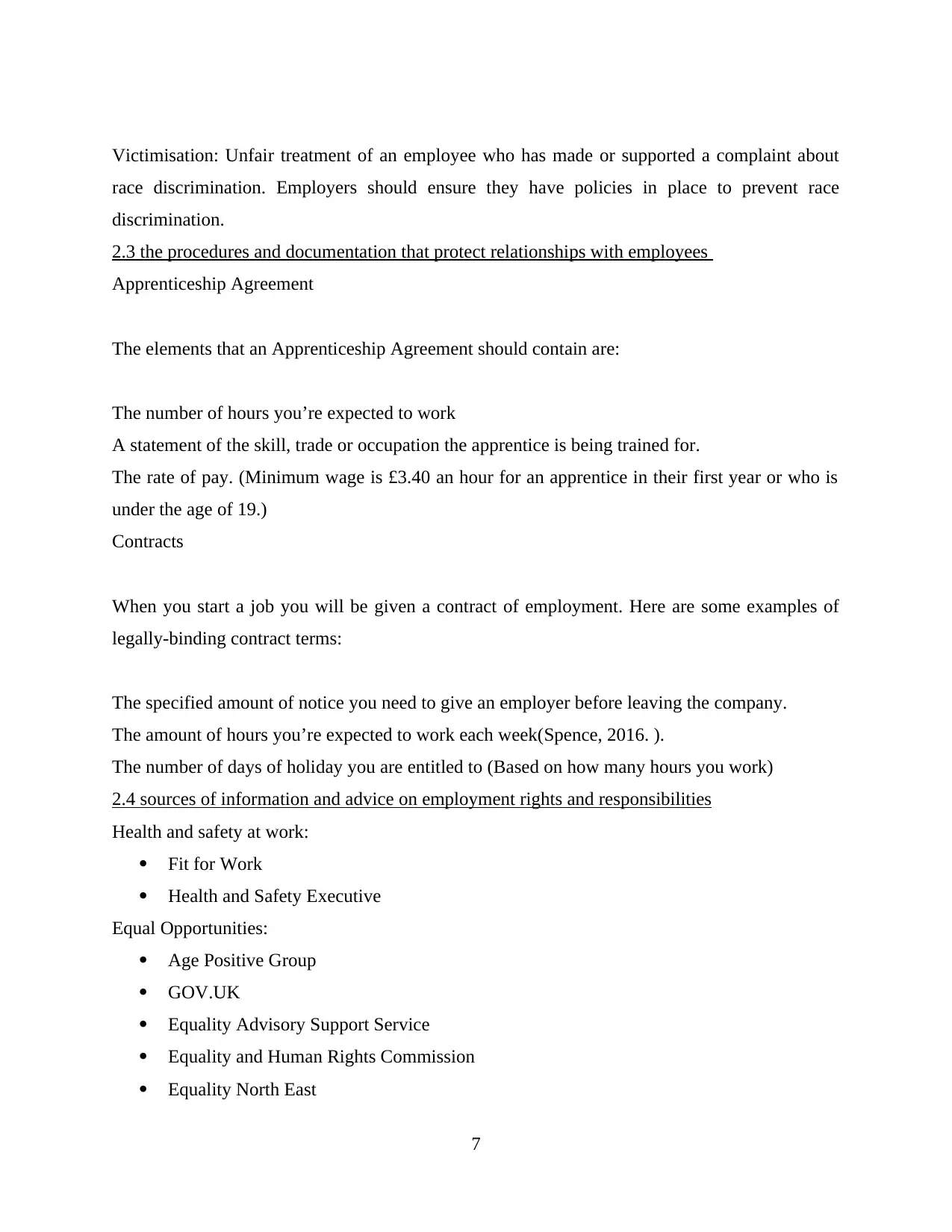
Victimisation: Unfair treatment of an employee who has made or supported a complaint about
race discrimination. Employers should ensure they have policies in place to prevent race
discrimination.
2.3 the procedures and documentation that protect relationships with employees
Apprenticeship Agreement
The elements that an Apprenticeship Agreement should contain are:
The number of hours you’re expected to work
A statement of the skill, trade or occupation the apprentice is being trained for.
The rate of pay. (Minimum wage is £3.40 an hour for an apprentice in their first year or who is
under the age of 19.)
Contracts
When you start a job you will be given a contract of employment. Here are some examples of
legally-binding contract terms:
The specified amount of notice you need to give an employer before leaving the company.
The amount of hours you’re expected to work each week(Spence, 2016. ).
The number of days of holiday you are entitled to (Based on how many hours you work)
2.4 sources of information and advice on employment rights and responsibilities
Health and safety at work:
Fit for Work
Health and Safety Executive
Equal Opportunities:
Age Positive Group
GOV.UK
Equality Advisory Support Service
Equality and Human Rights Commission
Equality North East
7
race discrimination. Employers should ensure they have policies in place to prevent race
discrimination.
2.3 the procedures and documentation that protect relationships with employees
Apprenticeship Agreement
The elements that an Apprenticeship Agreement should contain are:
The number of hours you’re expected to work
A statement of the skill, trade or occupation the apprentice is being trained for.
The rate of pay. (Minimum wage is £3.40 an hour for an apprentice in their first year or who is
under the age of 19.)
Contracts
When you start a job you will be given a contract of employment. Here are some examples of
legally-binding contract terms:
The specified amount of notice you need to give an employer before leaving the company.
The amount of hours you’re expected to work each week(Spence, 2016. ).
The number of days of holiday you are entitled to (Based on how many hours you work)
2.4 sources of information and advice on employment rights and responsibilities
Health and safety at work:
Fit for Work
Health and Safety Executive
Equal Opportunities:
Age Positive Group
GOV.UK
Equality Advisory Support Service
Equality and Human Rights Commission
Equality North East
7
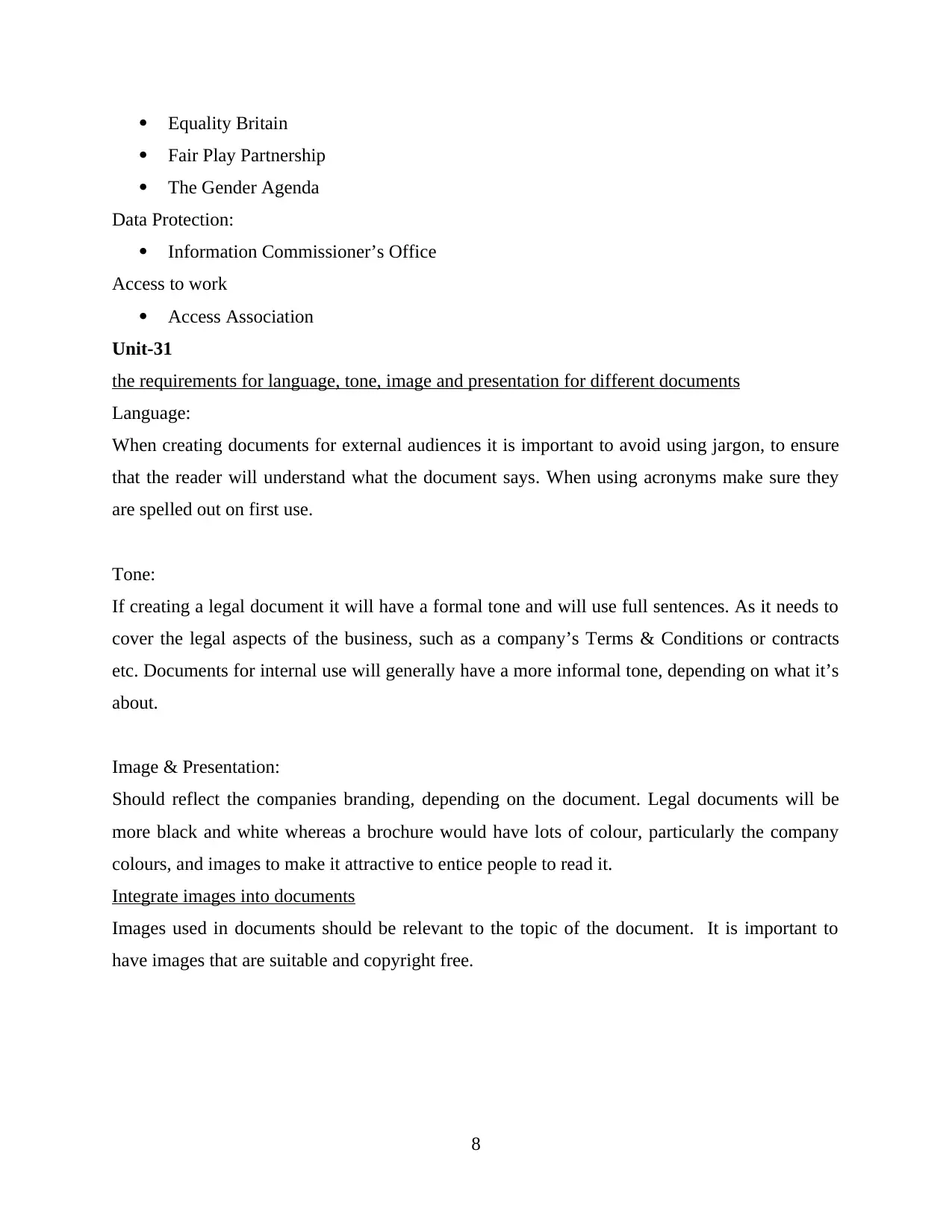
Equality Britain
Fair Play Partnership
The Gender Agenda
Data Protection:
Information Commissioner’s Office
Access to work
Access Association
Unit-31
the requirements for language, tone, image and presentation for different documents
Language:
When creating documents for external audiences it is important to avoid using jargon, to ensure
that the reader will understand what the document says. When using acronyms make sure they
are spelled out on first use.
Tone:
If creating a legal document it will have a formal tone and will use full sentences. As it needs to
cover the legal aspects of the business, such as a company’s Terms & Conditions or contracts
etc. Documents for internal use will generally have a more informal tone, depending on what it’s
about.
Image & Presentation:
Should reflect the companies branding, depending on the document. Legal documents will be
more black and white whereas a brochure would have lots of colour, particularly the company
colours, and images to make it attractive to entice people to read it.
Integrate images into documents
Images used in documents should be relevant to the topic of the document. It is important to
have images that are suitable and copyright free.
8
Fair Play Partnership
The Gender Agenda
Data Protection:
Information Commissioner’s Office
Access to work
Access Association
Unit-31
the requirements for language, tone, image and presentation for different documents
Language:
When creating documents for external audiences it is important to avoid using jargon, to ensure
that the reader will understand what the document says. When using acronyms make sure they
are spelled out on first use.
Tone:
If creating a legal document it will have a formal tone and will use full sentences. As it needs to
cover the legal aspects of the business, such as a company’s Terms & Conditions or contracts
etc. Documents for internal use will generally have a more informal tone, depending on what it’s
about.
Image & Presentation:
Should reflect the companies branding, depending on the document. Legal documents will be
more black and white whereas a brochure would have lots of colour, particularly the company
colours, and images to make it attractive to entice people to read it.
Integrate images into documents
Images used in documents should be relevant to the topic of the document. It is important to
have images that are suitable and copyright free.
8
⊘ This is a preview!⊘
Do you want full access?
Subscribe today to unlock all pages.

Trusted by 1+ million students worldwide
1 out of 23
Related Documents
Your All-in-One AI-Powered Toolkit for Academic Success.
+13062052269
info@desklib.com
Available 24*7 on WhatsApp / Email
![[object Object]](/_next/static/media/star-bottom.7253800d.svg)
Unlock your academic potential
Copyright © 2020–2025 A2Z Services. All Rights Reserved. Developed and managed by ZUCOL.





